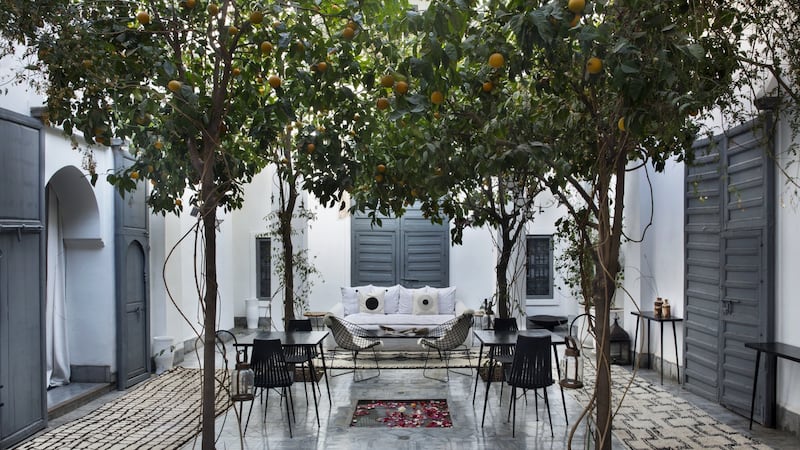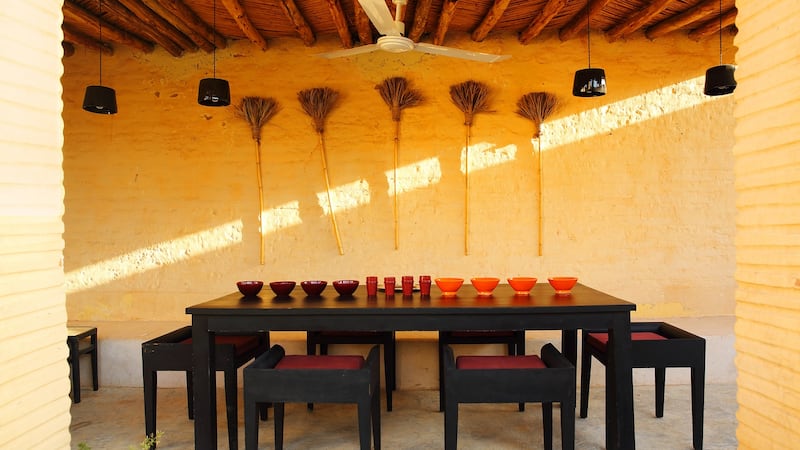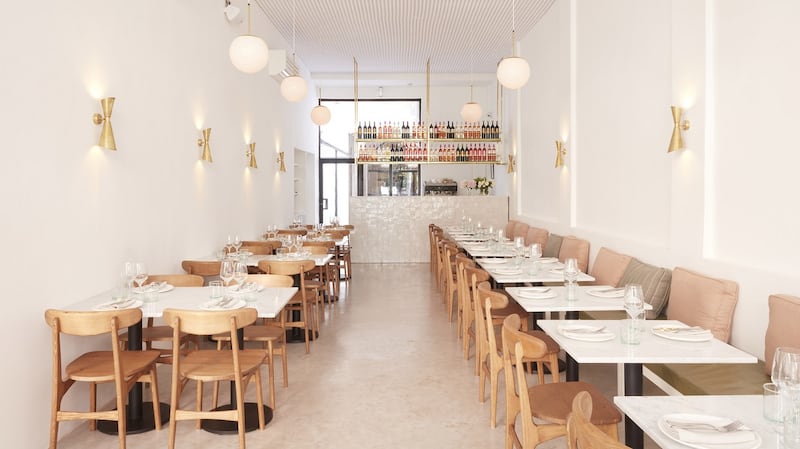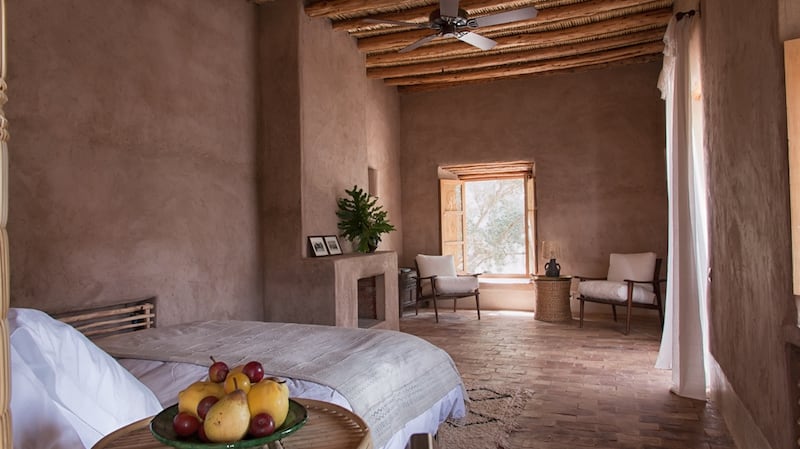"I believe that Marrakesh ought to be earned as a destination. The journey is the preparation for the experience. Reaching it too fast derides it, makes it a little less easy to understand."
Tahir Shah, In Arabian Nights
Morocco, and especially Marrakesh, remains the ultimate escape. The immediacy of today's air travel renders it at once just another destination, yet it is not. It's a deeply layered culture and society, rooted in craft, tradition and humanity.
At every turn and in every moment, Morocco gives on levels we have almost forgotten exist, but we have to slow down to really appreciate the experience. In the West we ask direct questions and get direct answers. In Morocco it is not at all as straight forward – which can frustrate people – but the results are so subtle that you can’t but be transfixed. If you go, open your heart to these experiences and you will be profoundly rewarded.
This is how I enjoy Morocco, where you have to plan your days, so as not to be overwhelmed. I recommend staying only two nights in the medina and no more. I love to stay in Riad Dar Kawa, owned by a Belgian couple Valerie and Eric Barkowski. Situated beside La Maison de la Photographie, it is simply designed with dove grey woodwork and African influences.
Valerie is often there to help with recommendations and also has an amazing shop of the same name in Bab Doukkala, where she works with local artisans to produce home textiles. She also serves couscous Fridays every week, which is a great way to meet local creatives.


Leaving your riad late morning, I recommend having a lunch reservation to make life easy. I like La Famille in Riad Zitoune Jdid. Meander slowly through the medina past the souq des epices (spice souk) and arrive for lunch in La Famille’s bird-filled garden setting. Here, you can enjoy lemon pasta, flatbreads and dips and bergamot orange juices with raspberry tart.
Revived, head back out to the life-affirming madness.
In no particular order, I'd recommend visiting Chez Soufiane in the Riad Laarouss, the most exquisite of rug sellers and a winner at La Maison Objet in Paris last year. This place turns the clichéd Moroccan rug seller stereotype on its head. Looking more like a hip-hop artist, Soufiane Zarib produces rugs of immense beauty reviving old designs and techniques. The space is huge and contemporary with pieces from boiler suits to art deco sofas and contemporary photography. With a new restaurant on the roof offering views out over the souks, this is a must stop.
African wicker flooring
Equally so is Mustapha Blaoui, Rue Bab Doukkala, which has three floors offering every craft you could want, from African wicker flooring to kelim covered armchairs. This is an essential stop, even for a look if you're not in the mood for spending. Break up your shopping with a visit to Le Jardin Secret, a former palace in the Medina with an Islamic garden, recently restored by English landscape architect Tom Stuart-Smith. It is just a short walk to two of my favourite shops, which are co-owned by Japanese designers. Michi, 21 Souk Kchachbia and Jasmine, Derb Smara Kandil: think Berber rustic square tablecloths, small wood utensils and customised baskets.
After all that shopping, you’ll need another break. Pop into Café Nomad at Souk des Epices mid-afternoon, order amalou (sesame), hibiscus and saffron ice-cream with a date and avocado shake.
French architectural duo Ko Studios designed the new museum, and the building in itself is worth the trip
After this, it’s time to retreat from the madness, sit on the roof of your riad, watch the sun set and the call to prayer ring out as you wait for your typically Moroccan dinner to arrive. Salads to start followed by tagine or couscous. It’s very difficult to eat well in Marrakesh and almost impossible at night, so the best option is to eat in your riad and rest after your busy day.
The following day go to the new part of town called Gueliz. Get a taxi there and head very early to the Musée Yves Saint Laurent: be there when they open at 10am, as it gets packed and very hot. The new museum is adjacent to the Jardins Majorelle and the Berber Museum – you can buy a ticket to all three. This was the home of YSL and his partner of 50 years, Pierre Berge. French architectural duo Ko Studios designed the new museum, and the building in itself is worth the trip. Inside, YSL's major collections sit in chiaroscuro, evocative of his signature noir smoking suits. The soundtrack is Maria Callas's Casta Diva. Further rooms document his ultimate muse Catherine Deneuve and her times in Marrakech. The visit ends with a film on his life in a wood-panelled cinema. The bookshop and the café in the garden are superb.
Afterwards, head for lunch at the new Plus61 restaurant, 96 Rue Mohammed el Beqal. This represents something new on the Marrakesh food scene with all-white marble tables, chrome lighting and blush-pink cushions. An Australian-owned restaurant, the food nods strongly to the freshness of that food scene coupling with the best of local produce – smoked salmon with the freshest and most pungent of rocket enjoyed with sparkling fresh pomegranate juice, and to finish lamingtons and rose tea. They are also open for dinner.

Gallery
Right beside Plus 61 is the studio of Artsi Ifrach aka Artsi, an Israeli fashion designer living in Marrakesh and producing couture and streetwear. While in the new town I also visit Galerie 127, 127 Avenue Mohammed V. French owner Natalie Locatelli has run this gallery for 16 years and shows work by Moroccan or international artists influenced or having worked there. The selection is progressive and insightful, and the building is a crumbling relic to another time. Finish up your day with a drink in the gardens of La Mamounia, Avenue Bab Jdid, and a walk around the extensive orange tree filled gardens.
On day three it is time to escape the medina. Heading even an hour outside of Marrakech will transport you to another world. Some of my favourite places include Kasbah Beldi by Lalla Lake and Kasbah du Toubkal in the high Atlas Mountains.
Berber Lodge, Province al Haouz Route du Barrage, is run by the eccentric Franco-Swiss owner and interior designer Romain Michel-Meniere. This is a collaborative project with Studio Ko (of the YSL museum). It was built on an ancient olive garden, with no tree was moved in the process. It opened in 2017 and last year hit the Condé Nast hot list for its pared-back elegance and rustic design. Roaring fires, sheepskins, raffia lamp shades hanging low over colourful table settings, European Moroccan-influenced food and kind service from the local Berbers. There is nothing to do here and it is in the middle of nowhere. It couldn’t be more perfect.

The next stop is the legendary Kasbah Bab Ourika, in the Ourika valley. A crumbling road leads to the Kasbah on the mountaintop overlooking the national park. The famous afternoon tea on the terrace can be enjoyed each day and the long lazy dinners have influences from Ibiza. The rooms are charming and filled with pieces from the flea markets of Marrakech. This is a perfect romantic hideout; a place more from the pages of a novel than from real life.
After a short stay here you will have a greater understanding of the diversity and depth of a culture which mixes local tradition with global influences. This comes easily to a polyglot nation that has been conquered throughout its history by Africans, Ottomans, Arabs, French and latterly the design jet set. In a world consumed by too much tourism, Morocco’s ability to maintain its exotic other world feeling is the result of an unfaltering sense of place and people. If you haven’t gone, go now and come back enlivened, warmed and enriched.














